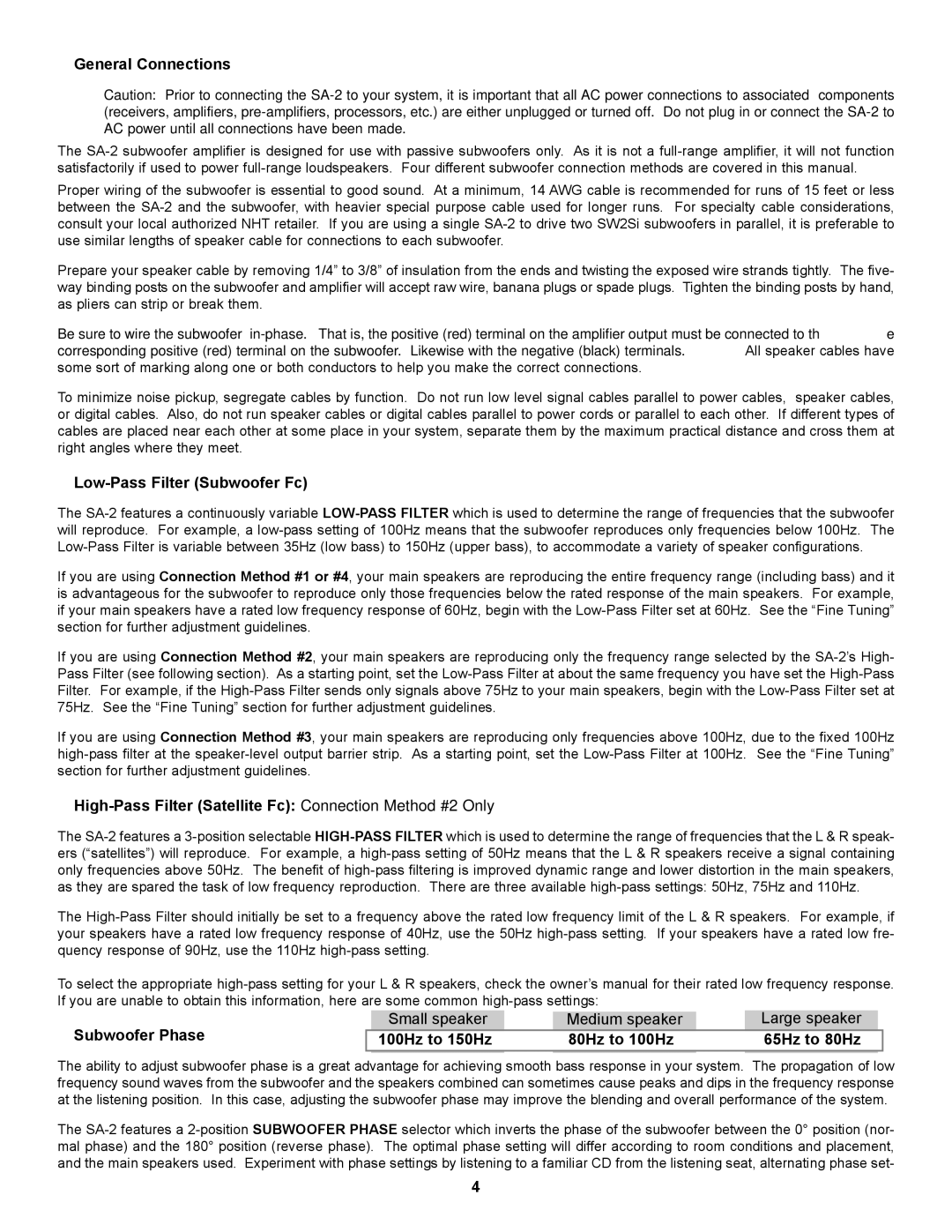General Connections
Caution: Prior to connecting the SA-2 to your system, it is important that all AC power connections to associated components (receivers, amplifiers, pre-amplifiers, processors, etc.) are either unplugged or turned off. Do not plug in or connect the SA-2 to AC power until all connections have been made.
The SA-2 subwoofer amplifier is designed for use with passive subwoofers only. As it is not a full-range amplifier, it will not function satisfactorily if used to power full-range loudspeakers. Four different subwoofer connection methods are covered in this manual.
Proper wiring of the subwoofer is essential to good sound. At a minimum, 14 AWG cable is recommended for runs of 15 feet or less between the SA-2 and the subwoofer, with heavier special purpose cable used for longer runs. For specialty cable considerations, consult your local authorized NHT retailer. If you are using a single SA-2 to drive two SW2Si subwoofers in parallel, it is preferable to use similar lengths of speaker cable for connections to each subwoofer.
Prepare your speaker cable by removing 1/4” to 3/8” of insulation from the ends and twisting the exposed wire strands tightly. The five- way binding posts on the subwoofer and amplifier will accept raw wire, banana plugs or spade plugs. Tighten the binding posts by hand, as pliers can strip or break them.
Be sure to wire the subwoofer “in-phase.” That is, the positive (red) terminal on the amplifier output must be connected to the corresponding positive (red) terminal on the subwoofer. Likewise with the negative (black) terminals. All speaker cables have some sort of marking along one or both conductors to help you make the correct connections.
To minimize noise pickup, segregate cables by function. Do not run low level signal cables parallel to power cables, speaker cables, or digital cables. Also, do not run speaker cables or digital cables parallel to power cords or parallel to each other. If different types of cables are placed near each other at some place in your system, separate them by the maximum practical distance and cross them at right angles where they meet.
Low-Pass Filter (Subwoofer Fc)
The SA-2 features a continuously variable LOW-PASS FILTER which is used to determine the range of frequencies that the subwoofer will reproduce. For example, a low-pass setting of 100Hz means that the subwoofer reproduces only frequencies below 100Hz. The Low-Pass Filter is variable between 35Hz (low bass) to 150Hz (upper bass), to accommodate a variety of speaker configurations.
If you are using Connection Method #1 or #4, your main speakers are reproducing the entire frequency range (including bass) and it is advantageous for the subwoofer to reproduce only those frequencies below the rated response of the main speakers. For example, if your main speakers have a rated low frequency response of 60Hz, begin with the Low-Pass Filter set at 60Hz. See the “Fine Tuning” section for further adjustment guidelines.
If you are using Connection Method #2, your main speakers are reproducing only the frequency range selected by the SA-2’s High- Pass Filter (see following section). As a starting point, set the Low-Pass Filter at about the same frequency you have set the High-Pass Filter. For example, if the High-Pass Filter sends only signals above 75Hz to your main speakers, begin with the Low-Pass Filter set at 75Hz. See the “Fine Tuning” section for further adjustment guidelines.
If you are using Connection Method #3, your main speakers are reproducing only frequencies above 100Hz, due to the fixed 100Hz high-pass filter at the speaker-level output barrier strip. As a starting point, set the Low-Pass Filter at 100Hz. See the “Fine Tuning” section for further adjustment guidelines.
High-Pass Filter (Satellite Fc): Connection Method #2 Only
The SA-2 features a 3-position selectable HIGH-PASS FILTER which is used to determine the range of frequencies that the L & R speak- ers (“satellites”) will reproduce. For example, a high-pass setting of 50Hz means that the L & R speakers receive a signal containing only frequencies above 50Hz. The benefit of high-pass filtering is improved dynamic range and lower distortion in the main speakers, as they are spared the task of low frequency reproduction. There are three available high-pass settings: 50Hz, 75Hz and 110Hz.
The High-Pass Filter should initially be set to a frequency above the rated low frequency limit of the L & R speakers. For example, if your speakers have a rated low frequency response of 40Hz, use the 50Hz high-pass setting. If your speakers have a rated low fre- quency response of 90Hz, use the 110Hz high-pass setting.
To select the appropriate high-pass setting for your L & R speakers, check the owner’s manual for their rated low frequency response. If you are unable to obtain this information, here are some common high-pass settings:
| | Small speaker | | | | Large speaker | |
Subwoofer Phase | | | Medium speaker | |
| 100Hz to 150Hz | | 80Hz to 100Hz | | 65Hz to 80Hz | |
| | | | | | | |
The ability to adjust subwoofer phase is a great advantage for achieving smooth bass response in your system. The propagation of low frequency sound waves from the subwoofer and the speakers combined can sometimes cause peaks and dips in the frequency response at the listening position. In this case, adjusting the subwoofer phase may improve the blending and overall performance of the system.
The SA-2 features a 2-position SUBWOOFER PHASE selector which inverts the phase of the subwoofer between the 0° position (nor- mal phase) and the 180° position (reverse phase). The optimal phase setting will differ according to room conditions and placement, and the main speakers used. Experiment with phase settings by listening to a familiar CD from the listening seat, alternating phase set-
